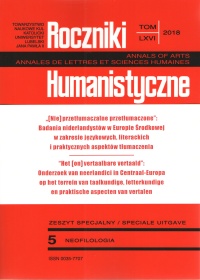Language, culture, and translation: A semiotic approach
Abstract
The dilemma with translation of cultural elements and with the relation of word and image in plurimodal texts, led to the choice of a semiotic theory of translation. In a semiotic approach culture is considered as a web of signs in which texts are an embedded subsystem. Semiotically, translation is primarily the transmission of a cultural artefact into another cultural system of signs. Unfortunately, this simplified vision ignores the translator as an active interface. Charles Sanders Pierce had rightly introduced a triadic sign representation (1985, 5) in which an adequate role is attributed to the translator who translates the sign into another system of signs, thus creating permanent cultural mobility. Semiotically, translation is an act of cultural identity formation. Semiosis may be executed exoticisingly or naturalisingly, but it remains an irreversible unidirectional process. Ultimately, a translation is an intercultural symbiotic construction.
References
Bassnett, Susan. 1980. Translation Studies. London, New York: Routledge.
Bassnett, Susan, & André Lefevere (eds.). 1990. Translation, History and Culture. London: Pinter.
Bassnett, Susan, & André Lefevere. 1998) Constructing Cultures. Clevedon: Multilingual Matters.
Benjamin, Walter. 1923. ‘The task of translator.’ In R. Schulte & John Biguenot (eds.). An anthology of essays from Dryden to Derrida, 71–82. Chicago: Chicago University Press.
Buden, Boris, Stefan Nowotny, Sherry Simon, Ashok Bery & Michael Cronin. 2009. ‘Cultural translation. An introduction to the problem, and Responses.’ Translation Studies 2 (2): 196–219.
Eco, Umberto. 2001. Experiences in Translation. Toronto, Buffalo, London: University of Toronto Press.
Geertz, Clifford. 1973. The Interpretation of Cultures. Selected Essays. London: Fontana Press.
Gorlée, Dinda L. 1994. Semiotics and the Problem of Translation. Amsterdam: Rodopi.
Gorlée, Dinda L. 2004. On Translating Signs. Exploring Text and Semio-Translation. Amsterdam: Rodopi.
Hoffman, Eva. 1996. Verloren in taal. Leven in een nieuw land. Baarn: Bodoni.
Holmes, James. 1977. ‘Wat is vertaalwetenschap?’ In Bernard T. Tervoort (ed.). Wetenschap en taal, deel 1. Muiderberg: Coutinho. Herdrukt in Ton Naaijkens, Cees Koster, Henri Bloemen & Caroline Meijer (eds.). 2004. Denken over vertalen. Tekstboek vertaalwetenschap, 149–162. Nijmegen: Vantilt.
Jakobson, Roman. 1959. ‘On Linguistic Aspects of Translation.’ In Reuben A. Brower (ed.). On Translation, 232–239. Cambridge, MA: Harvard University Press.
Jakobson, Roman. 1977. ‘A Few Remarks on Peirce. Pathfinder in the Science of Language.’ Modern Language Notes 92: 1026–1932.
Kourdis, Evangelos. 2015. ‘Semiotics of Translation.’ In Peter Pericles Trifonas (ed.). International Handbook of Semiotics, 303–320. Dordrecht: Springer.
Kourdis, Evangelos, & Pirjo Kukkonen (eds.). 2015. Semiotics of translation, translation in semiotics. Special issue of Punctum 1(2).
Kourdis, Evangelos, & Pirjo Kukkonen. 2015. ‘Introduction. Semiotics of translation, translation in semiotics.’ Punctum 1(2): 5–10.
Novaković, Jelica. 1995. ‘Alchemie en toverkracht.’ Literatuur I.
Peirce, Charles Sanders. 1985. ‘Logic as Semiotics: The Theory of Signs.’ In Robert E. Innis (ed.). Semiotics. An Introductory Anthology, 4–23. Bloomington: Indiana University Press.
Petrilli, Susan. 2003. Translation Translation. Amsterdam: Rodopi.
Saussure, Ferdinand de. 1962. Cours de linguistique générale. Paris: Payot.
Singh, Rajendra. 2007. ‘Unsafe at any speed? Some unfinished reflections on the ‘cultural turn’ in Translation Studies.’ In Paul St-Pierre & Kar C. Prafulla (eds.). In Translation, Reflections, Refractions, Transformations, 73–84. Amsterdam: John Benjamins.
Stecconi, Ubaldo. 2004. ‘Interpretive semiotics and translation theory. The semiotic conditions to translation.’ Semiotica 4 (1).
Stecconi, Ubaldo. 2007. ‘Five reasons why semiotics is good for Translation Studies.’ In Yves Gambier, Miriam Schlesinger & Radegundis Stolze (eds.). Doubts and Directions in Translation Studies, 15–20. Amsterdam: John Benjamins.
Stecconi, Ubaldo. 2009. ‘Semiotics.’ In Mona Baker & Gabriela Saldanha (eds.). Routledge Encyclopedia of Translation Studies, 260–263. London, New York: Routledge.
Sütiste, Elin. 2012. ‘Preface. On the path of translation semiotics with Peeter Torop.’ Sign Systems Studies 40 (3/4): 269–278.
Toury, Gideon. 1986. ‘Translation: A Cultural-Semiotic Perspective.’ In Thomas Sebeok (ed.). Encyclopedic Dictionary of Semiotics, vol. 2: 1111–1124. Berlin: De Gruyter.
Torop, Peeter. 2002. ‘Translation as translating as culture.’ Sign Systems Studies 30 (2): 593–605.
Torop, Peeter. 2008. ‘Translation and semiotics.’ Sign Systems Studies 36(2): 253–257.
Venuti, Lawrence. 1998. The Scandals of Translation: Towards an Ethics of Difference. London: Routledge.
Copyright (c) 2018 Roczniki Humanistyczne

This work is licensed under a Creative Commons Attribution-NonCommercial-NoDerivatives 4.0 International License.





